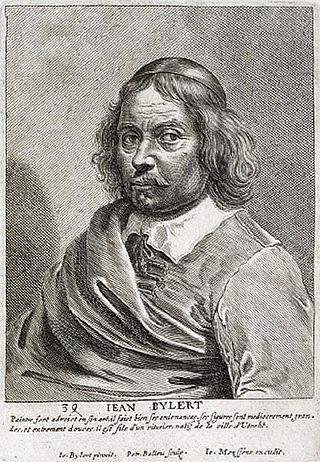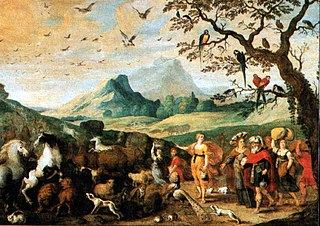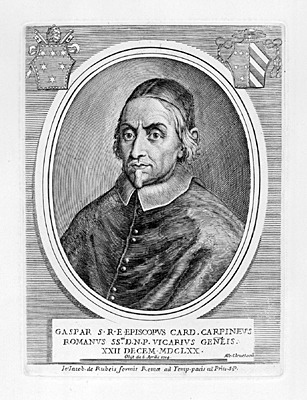
Cornelis van Poelenburgh or Cornelis van Poelenburch, was a Dutch landscape painter and draughtsman. He was the leading representative of the first generation of Dutch landscape painters who were active in Rome in the early 17th century. He was known for small-scale paintings depicting Italianate landscapes with small figures enacting biblical or mythological scenes or in contemporary attire.

The Bentvueghels were a society of mostly Dutch and Flemish artists active in Rome from about 1620 to 1720. They are also known as the Schildersbent.

Bartholomeus Breenbergh was a Dutch Golden Age painter of Italian and Italianate landscapes, in Rome (1619-1630) and Amsterdam (1630-1657).

Cornelis Schut was a Flemish painter, draughtsman, engraver and tapestry designer who specialized in religious and mythological scenes. Presumed to have trained under Rubens, he treated Counter-Reformation subjects in a High-Baroque style. After a stay in Italy, he worked mainly in Antwerp where he was one of the leading history painters in the first half of the 17th century.

Jan Erasmus Quellinus was a Flemish painter and draughtsman and a member of the famous Quellinus family of artists. He was one of the last prominent representatives of the great Flemish school of history and portrait painting in the 17th century. His work displays the classicizing influences of his father Erasmus Quellinus the Younger and Paolo Veronese. Mainly active in his native Antwerp, he worked for some time in Vienna for the Habsburg court as a court painter to Emperor Leopold I.

Jan Hermansz van Bijlert was a Dutch Golden Age painter from Utrecht, one of the Utrecht Caravaggisti whose style was influenced by Caravaggio. He spent some four years in Italy and was one of the founders of the Bentvueghels circle of northern painters in Rome.

Lucas de Wael was a Flemish painter, art dealer and merchant. He was born in Antwerp and worked for some time in Genoa in Italy before returning to Antwerp. Here he continued his artistic and commercial activities. He is known for his landscapes and genre scenes.

Hans Jordaens the Elder (1555–1630), was a Flemish Baroque painter whose religious works are often confused with that of other painters with the same name.

Abraham Genoels II or Abraham Genouil was a Flemish Baroque painter, draughtsman, engraver and tapestry designer. He is now mainly known for his landscape paintings, drawings and prints. He had an international career that saw him work in Paris, Rome and Antwerp.

Anton Goubau or Anton Goebouw was a Flemish Baroque painter. He spent time in Rome where he moved in the circle of the Bamboccianti, Dutch and Flemish genre painters who created small cabinet paintings of the everyday life of the lower classes in Rome and its countryside. He is known for his Italianate landscapes and genre paintings in the style of the Bamboccianti and his history paintings with mythological and religious themes.

Jacob Ferdinand Voet or Jakob Ferdinand Voet was a Flemish portrait painter. He had an international career that brought him to Italy and France, where he made portraits for an elite clientele. Voet is regarded as one of the best and most fashionable portrait painters of the High Baroque.
Jacobus de Baen, was a Dutch Golden Age portrait painter who was the son of Jan de Baen.

Bernard de Bailliu was a Flemish reproductive engraver who was active in Antwerp and Rome.

Pieter Hofman, was a Flemish Baroque painter. After training in Antwerp, he spent the rest of his career in Turkey and Italy where he painted battle scenes.
Jan Baptist Brueghel was a Flemish Baroque flower painter.

Albertus Clouwet, was a Flemish engraver who had a successful career in Italy.

Jan van Essen, was a Flemish painter known for his seascapes. After training in Antwerp, he worked in Italy, particularly in Rome and Naples.

Franciscus de Neve (II) (also: Frans de (II) Neve, Fraciscus de Neuff, Francesco della Neve and nicknames: Bloosaerken and Blaserken) (1632, Antwerp – after 1704) was a Flemish painter and engraver. He is known for his late Baroque religious and mythological scenes and landscapes. He had an international career in Italy, Southern Germany and Austria where he worked for aristocratic patrons and churches; He returned to his native Flanders later in his life.

Johan Zierneels was a Dutch painter who specialized in Christian religious themes.

Pieter Verbrugghen the Younger or Pieter Verbrugghen II(1648, Antwerp – after 1691, Antwerp) was a Flemish sculptor, draughtsman, etcher and stone merchant.


















